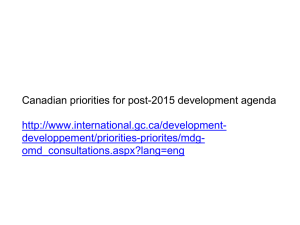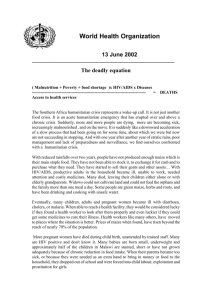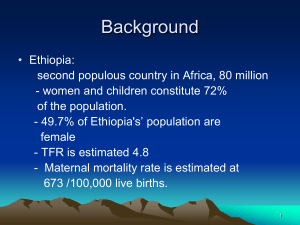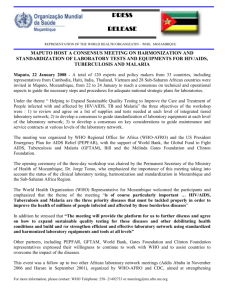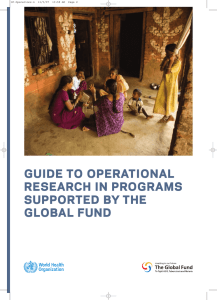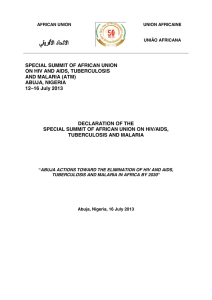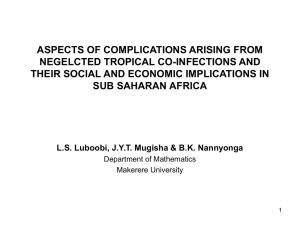The Future of Primary Health Care
advertisement
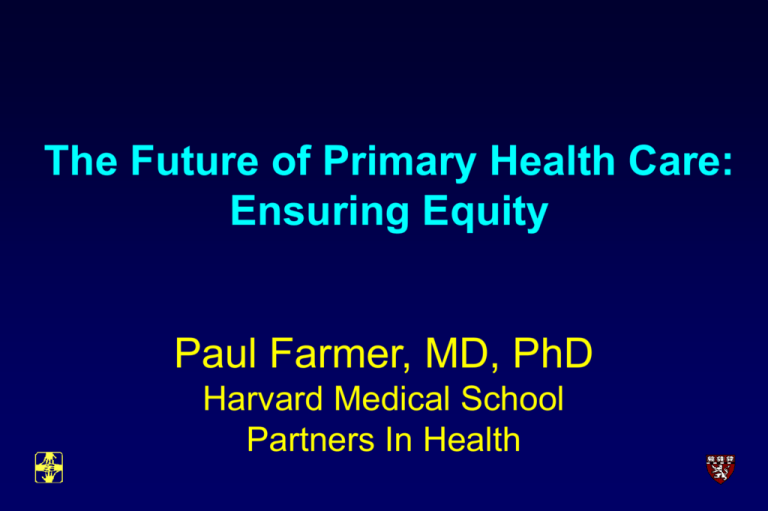
The Future of Primary Health Care: Ensuring Equity Paul Farmer, MD, PhD Harvard Medical School Partners In Health Priority Setting • Cardiovascular disease and cancer are the first cause of mortality in Latin America. • But the notification of cases of tuberculosis, malaria, and HIV/AIDS keeps increasing [1]: Tuberculosis Malaria HIV/AIDS 196,630 (1980) 535,273 (1980) 66,315 (until 1991) 232,262 (1995) 1,056,072 (1997) 31,699 (in 1995) • Need to continue research and investment on povertyrelated diseases. [1] OPS 2000. The Poor Bear the Burden of Infectious Disease: Percentage of Deaths from Infectious Disease that Occur in the Poorest 20% of the Global Population Malaria 57.9% Childhood Diseases 55.0% Diarrheal Diseases 53.2% Perinatal Conditions 45.0% Tuberculosis 44.4% Maternal Conditions 43.2% Respiratory Infections 42.6% HIV/AIDS 41.8% Source: Davidson R. Gwatkin, May 1999 Leading infectious killers millions of deaths, worldwide, 1999 4.5 4.0 million 4 3.5 2.7 million 3 2.2 million 2.5 1.7 million 2 1.1 million 1.5 1 0.5 0 Acute respiratory infections AIDS Diarrheal diseases TB Malaria Source: WHO, 2000 Infectious diseases as a cause of mortality: Worldwide vs. low-income countries, 1998 50% 45% 45% percent of total deaths 40% 35% 30% 25% 25% 20% 15% 10% 5% 0% worldwide Source: WHO, 1999 low-income countries Reported TB cases, U.S.-born and foreign-born persons United States, 1999 Foreign-born U.S.-born 43% 56% Unknown 1% Source: CDC, 1999 The Outcome Gap Grows Improved Outcomes Non-Poor Poor Time Introduction of effective technology Number of People per Physician Source: PAHO 2000 C ub a U rug uay A rg ent ina V enez uela R ep . D o minicana M éxico Ecuad o r C o st a R ica B o livia B rasil Panamá C o lo mb ia Perú C hile El Salvad o r Guat emala Ho nd uras N icarag ua Parag uay Hait í 0 2000 4000 6000 8000 10000 12000 14000 Number of surgeons per 100,000 population Cuba United States Japan Sweden Germany China Columbia United Kingdom South Africa Philippines Kenya Tanzania Bulletin of the American College of Surgeons, 1987 J. Perez, personal communication, 2000 56 51 31 29 13 10 7 6 6 1.5 0.6 0.3 Leading causes of maternal mortality, developing countries Cause of death % of deaths Hemorrhage 25-33% PIH/eclampsia 7.4-30% Sepsis, infection (including malaria, TB) 8.3-65% Uterine rupture 27.6% Anemia 30-65% Abortion up to 50% Stokoe U. Determinants of maternal mortality in the developing world. Aust NZ J Obstet Gynaecol 1991; 31:8-16. Highest Maternal Mortality per 100.000 Live Births Source: PAHO 2000 500 300 200 100 ra g ua a Ni ca G uy an al a m te G ua du ra s y Ho n ua ra g Pa B ol iv ia Pe ru 0 Ha iti Rate 400 Malaria: The Costs of Inequality • 300-500 million people are infected with malaria each year. • Malaria causes more than 1 million deaths each year, 90% of which occur in Sub-Saharan Africa. • If malaria had been eliminated 30 years ago, Africa’s GDP would have been as much as $100 billion greater in 2000. Sources: WHO 2001; WHO Press Release 2000 Tropical Disease Research Between 1975 and 1996, 1,233 new chemical entities were registered. Of that number, only 11 were for tropical diseases such as malaria. Source: Sylvia Pfeifer, “Public-Private Partnership Attacks Tuberculosis—Aim is to Spur Development of New Drugs,” Knight Ridder/ChicagoTribune, October 20, 2000. Current State of “AIDS Care” in Poor Countries • Palliative care – Programs in “community-based care” or “home care” are inadequate, even as hospice care – no real analgesia, no antifungals, too few antibacterials, no central or even peripheral lines for rehydration Why Prevention Alone Is Insufficient • Many of those at greatest risk of HIV infection already know that HIV is a sexually transmitted pathogen and that condoms could prevent transmission. • The risk of HIV in vulnerable populations stems less from ignorance than from the precarious situations in which millions live. • Gender inequality adds a special burden to women living in poverty. • Prevention programs ignore the 30 million people who are already infected. Meanwhile in the US: Deaths per 100,000 Population Trends in Age-Adjusted Death Rate due to HIV Infection,1982-1998 18 16 14 12 10 8 6 4 2 0 82 84 86 88 90 92 94 96 98** Year *Using the age distribution of the projected year 2000 US population as the standard. **Preliminary 1998 data Projected changes in life expectancy in selected African countries with high HIV prevalence, 1995–2000 65 Average life expectancy at birth, in years 60 55 Botswana Zimbabwe 50 45 Zambia Uganda Malawi 40 35 1955 1960 1965 1970 1975 1980 1985 1990 Source: United Nations Population Division, 1996 1995 2000 Fortune 500 Drug Industry Ranks #1 in All Measures of Profitability, 1999 35% 35.0% 30% 25% 20% 15% 18.3% 16.0% 15.4% 10% 5% 5.1% Fortune 500 Drug Industry All Fortune 500 Industries 4.5% 0% Median Median Median Profits as % Profits as % Profits as % of Equity of Revenue of Assets Source: Public Citizen’s Congress Watch (www.citizen.org), from Fortune Magazine, April 2000, Fortune 500 (www.fortune.com). The HIV Equity Initiative • To expand the treatment of HIV with HAART to those sick with AIDS in Haiti’s Central Plateau • Programmatic approach on successful DOTS-based tuberculosis-control efforts • The program gives medical and social support
